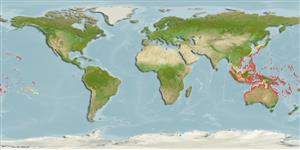Environment: milieu / climate zone / depth range / distribution range
Écologie
marin récifal; profondeur 0 - 60 m (Ref. 128797). Tropical; 37°N - 32°S, 95°E - 134°W
Pacific Ocean: widespread from Japan and Australia to the Tuamoto Islands and Hawaii. Replaced by Chaetodon trifasciatus in the Indian Ocean (Ref. 37816). DNA (from tissue samples) expected to further distinguished Chaetodon lunulatus and Chaetodon trifasciatus (Ref. 86689).
Length at first maturity / Taille / Poids / Âge
Maturity: Lm ?, range 8 - 8.4 cm
Max length : 26.7 cm TL mâle / non sexé; (Ref. 124696); poids max. publié: 191.24 g (Ref. 124696); âge max. reporté: 12 années (Ref. 56281)
Épines dorsales (Total): 13 - 14; Rayons mous dorsaux (Total): 20-22; Épines anales 3; Rayons mous anaux: 18 - 21.
Occur in monogamous pairs in coastal coral-rich areas (Ref. 47838, 48636). Juveniles hide among branches of small corals, often in lagoons (Ref. 9407). Benthopelagic (Ref. 58302). Feed solely on live corals (Ref. 47838). Oviparous (Ref. 205). Form pairs during breeding (Ref. 205).
Life cycle and mating behavior
Maturité | Reproduction | Frai | Œufs | Fécondité | Larves
Pairs form upon maturation for breeding purposes (Ref. 56281).
Allen, G.R., R. Steene and M. Allen, 1998. A guide to angelfishes and butterflyfishes. Odyssey Publishing/Tropical Reef Research. 250 p. (Ref. 47838)
Statut dans la liste rouge de l'IUCN (Ref. 130435)
Menace pour l'homme
Harmless
Utilisations par l'homme
Plus d'informations
RéférencesAquacultureProfil d'aquacultureSouchesGénétiqueElectrophoresesHéritabilitéPathologiesTraitementNutrientsMass conversion
Outils
Articles particuliers
Télécharger en XML
Sources Internet
Estimates based on models
Preferred temperature (Ref.
123201): 24.7 - 29.3, mean 28.3 °C (based on 1779 cells).
Phylogenetic diversity index (Ref.
82804): PD
50 = 0.5000 [Uniqueness, from 0.5 = low to 2.0 = high].
Bayesian length-weight: a=0.02291 (0.01133 - 0.04632), b=3.00 (2.83 - 3.17), in cm total length, based on LWR estimates for this Genus-body shape (Ref.
93245).
Niveau trophique (Ref.
69278): 3.3 ±0.61 se; based on food items.
Résilience (Ref.
120179): Haut, temps minimum de doublement de population inférieur à 15 mois (Preliminary K or Fecundity.).
Fishing Vulnerability (Ref.
59153): Low vulnerability (17 of 100).
Nutrients (Ref.
124155): Calcium = 146 [71, 260] mg/100g; Iron = 1.15 [0.64, 2.07] mg/100g; Protein = 18.7 [17.4, 19.9] %; Omega3 = 0.117 [0.060, 0.229] g/100g; Selenium = 44.1 [20.5, 94.6] μg/100g; VitaminA = 30.4 [7.8, 118.9] μg/100g; Zinc = 1.79 [1.12, 2.78] mg/100g (wet weight);
